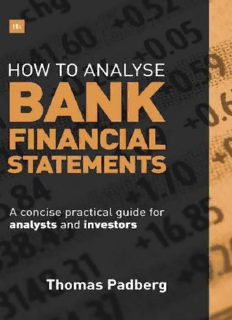
How to Analyse Bank Financial Statements: A Concise Practical Guide for Analysts and Investors PDF
Preview How to Analyse Bank Financial Statements: A Concise Practical Guide for Analysts and Investors
How to Analyse Bank Financial Statements A concise practical guide for analysts and investors Thomas Padberg HARRIMAN HOUSE HARRIMAN HOUSE LTD 18 College Street Petersfield Hampshire GU31 4AD GREAT BRITAIN Tel: +44 (0)1730 233870 Email: [email protected] Website: www.harriman-house.com First published in Great Britain in 2017 Copyright © Thomas Padberg The right of Thomas Padberg to be identified as the author has been asserted in accordance with the Copyright, Design and Patents Act 1988. Print ISBN: 978-0-85719-518-0 eBook ISBN: 978-0-85719-519-7 British Library Cataloguing in Publication Data A CIP catalogue record for this book can be obtained from the British Library. All rights reserved; no part of this publication may be reproduced, stored in a retrieval system, or transmitted in any form or by any means, electronic, mechanical, photocopying, recording, or otherwise without the prior written permission of the Publisher. This book may not be lent, resold, hired out or otherwise disposed of by way of trade in any form of binding or cover other than that in which it is published without the prior written consent of the Publisher. Whilst every effort has been made to ensure that information in this book is accurate, no liability can be accepted for any loss incurred in any way whatsoever by any person relying solely on the information contained herein. No responsibility for loss occasioned to any person or corporate body acting or refraining to act as a result of reading material in this book can be accepted by the Publisher, by the Author, or by the employers of the Author. For Rhea Contents About the author Acknowledgements Preface 1. Introduction 2. Specifics of Bank Financial Statement Analysis 3. Accounting Rules for Banks 4. Analysis of Segment Reporting 5. Ratios for Bank Financial Statement Analysis 6. Analysis of the Profit and Loss Account 7. Equity Analysis 8. Stock Analysis 9. Conclusion About the author Thomas Padberg, 41, is a German author. He completed his PhD on the subject of bank financial statement analysis and afterwards worked as a trainer and in- house consultant for many German banks within their specialist departments dedicated to this function. The German edition of his book – Bankbilanzanalyse – is now in its third edition and has become the standard reference work for the analysis of bank financial statements in Germany. You can contact the author at: [email protected] Acknowledgements This book is the culmination of 20 years of research, accompanied by many changes in accounting rules and financial crises. My greatest debt is to my long-time co-author Thomas Werner, with whom many analysis ideas used in this book were developed. Many other people played important roles in encouraging, challenging and critiquing me over the years. I would particularly like to thank my brothers Carsten and Christoph, Rolf Beike, Horst Gräfer, Thomas Kriete, Petra Oesterwinter, Bettina Schiller, Christiane Sorgenfrei, and Dagmar Tytko. Last, but not least, I was very lucky to have a wonderful, insightful and extremely supportive editor, Craig Pearce. Craig’s comments and suggestions have greatly improved this book, and his support for the project made the last year much more pleasant than it might have been without him. Preface What this book covers This book is about how to analyse bank financial statements. Bank financial statement analysis has to consider both banking supervision rules and banking accounting rules. These rules are not described in detail here, because this book is about the analysis and not about the rules. Therefore, it is expected that the reader has some background knowledge of these topics. The data used in this book is mostly from the year 2014. It is already old data, but that does not impact the usefulness of the analysis methods shown in this book. The reader can use these methods to analyse any other bank financial statements.
Description: